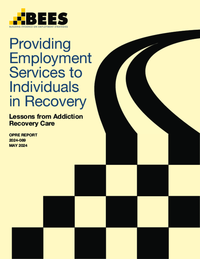Providing Employment Services to Individuals in Recovery
Lessons from Addiction Recovery Care

This report explores Addiction Recovery Care (ARC), a large-scale program in Kentucky combining residential clinical treatment for substance use disorders (SUDs) with employment services. ARC operates in several locations across the state, but is located primarily in rural, Appalachian areas hard-hit by the opioid crisis. ARC uses evidence-based approaches for treating SUDs, including both medications for opioid use disorder and procedures recommended by the American Society of Addiction Medicine for matching patients to levels of care. These SUD residential treatment and recovery services are combined with employment services including job readiness training, internships, and online courses leading to a range of short-term occupational certifications. Employment services are provided in the later phases of the residential program when participants are relatively stabilized in terms of their SUD recovery.
Studies of programs that combine employment services with SUD treatment and recovery services are part of the Building Evidence on Employment Strategies (BEES) Project, funded by the Office of Planning, Research, and Evaluation in the Administration for Children and Families within the U.S. Department of Health and Human Services. In addition to providing evidence on the impact of such programs, BEES is documenting the characteristics and operations of SUD employment programs, including ARC. The ARC program’s impact study was discontinued due to challenges in recruiting a sufficient study sample. Instead, BEES conducted a descriptive study to document the ARC program’s approach to providing employment services to individuals receiving SUD treatment and recovery supports. This report presents those descriptive study findings; it does not address the effects of program services on participants’ outcomes.
Primary Research Questions
The research questions guiding this report are:
- How is the program structured and operated, including organizational partnerships, population served, SUD treatment service provision, employment service provision, and other services?
- What are the participation patterns in the ARC program, including types of services received and length of participation?
- What are the lessons learned from program implementation, including successes and challenges?
Purpose
In recent years, in large part due to the opioid crisis, the federal government has increased its focus on and funding for programs that address both treatment and employment outcomes for people with SUDs. Such programs combine employment services with SUD treatment or recovery efforts to achieve the dual goals of sustaining recovery and improving economic well-being. This report documents one program that combines SUD treatment and recovery services with employment services. It also offers recommendations for those implementing similar programs or that are interested in developing them.
Key Findings and Highlights
- The ARC program provides participants with a mix of treatment, sober housing, employment services, and supportive services in four distinct phases. Phase 1: Stabilization includes medically supervised detoxification at a residential facility. Phase 2: Recovery and Life Skills provides continued treatment in supportive housing. Phase 3: Taking Action includes job-readiness services and treatment in supportive housing. Phase 4: Job Skills and Education includes occupational training, internships, and treatment in supportive housing. Most ARC participants admitted during the study period who started Phase 2 moved on to Phase 3, but only 9 percent of participants moved on to Phase 4 and received occupational training and internship experiences by the end of the study’s two-year follow-up period.
- The majority of ARC participants were White, single men between the ages of 24 and 44 and were diagnosed with a variety of SUDs at the time of their admission. About one-fourth of the participants were court-ordered to receive services at ARC, meaning that they were required to receive SUD treatment services at ARC as a condition of their sentencing. Among ARC participants, opioid-related diagnoses were the most prevalent type of SUD (more than three-fourths) followed by “other” stimulant disorders (that may include methamphetamines). The large number reported in each category indicates participants likely misused several types of drugs; two-thirds of participants received a polysubstance misuse diagnosis.
- ARC tailors occupational training to meet the needs of those with SUDs. Occupational training and short-term certificates are primarily offered through a college founded by ARC specifically to serve ARC participants. ARC’s training is tied to available employment opportunities in the community that are suitable for individuals with SUDs. Instructors are attuned to the needs and challenges of students in recovery and training is provided virtually to fit participants’ schedules and recovery-related activities.
- ARC combines internships with occupational training. ARC provides internships that are closely linked to participants’ occupational training. This approach allows participants to gain both the technical skills needed for specific positions, as well as experience applying those skills in paid, on-the-job settings. Participants who complete occupational training and internships obtain both short-term certificates and relevant work experience, potentially enhancing their longer-term employment prospects.
- ARC’s experiences combining residential clinical treatment for SUDs with employment services suggest lessons for policymakers and practitioners considering similar initiatives. Programs should include a “recovery transition” period during which participants are gradually prepared for employment. Occupational training should be tailored to meet the needs of individuals with SUDs. Programs should identify strategies to develop internship opportunities and those internships should be combined with occupational training to build participants’ skills and work experience. Finally, programs should consider strategies to minimize attrition and to help participants find jobs when they leave treatment programs or residential settings.
Methods
The report is based on two data sources: (1) interviews with program staff members, partners, and program participants conducted during site visits to ARC headquarters and three of its largest residential facilities in the fall of 2022; and (2) ARC administrative data that documents participants’ characteristics and participation patterns in the program.
Glossary
Substance use disorder: Substance use disorder results from the prolonged, repeated use of alcohol or other substances at high doses or high frequencies. Disorders can range from mild and temporary to serious and chronic.
Opioid use disorder: Opioid use disorder results from the prolonged, repeated use of opioids at high doses or chronic frequencies. Opioid use disorder has two characteristics that distinguish it from some other substance use disorders. First, opioids lead to physical dependence very quickly. Second, the abrupt cessation of opioid use leads to severe withdrawal symptoms, which give people an incentive to continue using opioids.
Treatment and recovery services: Treatment services treat substance use disorders directly, and recovery services support success in the recovery process, during or after treatment.
Document Details
Koralek, Robin, Hannah Engle, Chelsea Jackson, and Hannah Pico.
2024. Providing Employment Services to Individuals in Recovery: Lessons from Addiction Recovery Care. OPRE Report 2024-089. Washington, DC: Office of Planning, Research, and Evaluation, Administration for Children and Families, U.S. Department of Health and Human Services.






